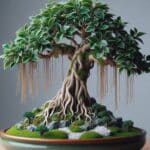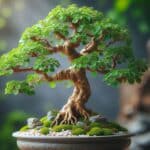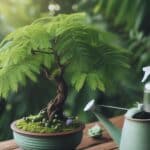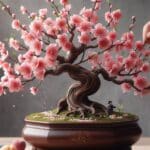A bonsai orange tree is one of the cutest miniature trees you can possibly grow. These charming trees produce vivid lime-green foliage that will brighten up your spaces throughout the year. They produce fragrant flowers in spring and summer and can bring lots of cheer when their small oranges start to ripen.
Orange bonsai trees are not only beautiful to behold, but their fruits are also edible and are usually enjoyed whole without peeling them.
It is a lot of fun to grow your own citrus bonsai tree and these small trees are quite hardy which do make them suitable for bonsai beginners. Growers should be aware that these small trees do, however, require a lot of patience and quite a bit of care to keep them in good condition.
In this guide, we are going to show you what variety of orange you should select, we teach you how to grow a bonsai orange tree and we share some great bonsai care tips that can keep your tree healthy and beautiful.
Orange Tree Plant Facts
| Scientific name | Citrus x citrofortunella mitis |
| Common names | Calamondin orange tree, bonsai orange tree, Calamansi, Musk Lime, Panama Orange, Golden Lime, China Orange, Limau Kesturi, Limau Chuit |
| Family | Rutaceae |
| Plant Type | Houseplant, Citrus tree, or Bonsai tree |
| Height and Width | 10 – 20 ft. tall (Inground), 1–3 ft. tall (bonsai) |
| Origin | China |
| Flower colors | White with yellow fruit |
| Foliage color | Light green |
| Sun Exposure | Direct sunlight? Indirect? etc? |
| Soil Type & pH | Well-drained, slightly acidic soil |
| Special features | Medium maintenance, Good for Containers, Fragrant blooms, edible fruits, Suitable for Bonsai |
What Does a Orange Bonsai Tree Look Like
An orange bonsai tree is a miniature version of a full-sized orange tree. They are small ornamental trees with vivid evergreen leaves and they even produce flowers and small edible fruits. The bright white flowers or tiny yellow or orange fruits can make these tiny citrus trees look quite attractive and can increase seasonal interest.
When orange trees are turned into bonsai form, the artists usually invest a lot of effort in structuring the trunk, stem, and roots so the little tree will appear more aged and so it will look like a smaller scale of mature tree.
The small trees can be crafted into all sorts of shapes. The most common bonsai shapes for orange trees include shapes like the cascade, semi-cascade, slanting, and S-curve designs.
If you love to own a fruit bonsai, an orange tree bonsai is a good start.
Common Varieties and Cultivars for a Bonsai Orange Tree
If you want to grow a beautiful orange bonsai tree then it is best to start with a suitable variety. Many orange and lemon tree varieties can be transformed into a bonsai form but most average or common citrus tree varieties are only suitable for imperial bonsai (larger bonsai types) because the leaves and fruits tend to be quite large even after being trained.
The best cultivar for creating miniature orange trees with attractive small-scale foliage and small fruit is the calamondin orange (Citrus x citrofortunella mitis).
This variety of orange trees is a variety of kumquat and naturally produces small fruits. In their natural form, these trees usually only grow 10 – 20 feet tall and they tend to be much more successful for bonsaiing and the miniature orange trees tend to look much more scaled thanks to their small fruit and foliage.
If you cannot get a hold of a calamondin orange then you can also consider growing a Trifoliate orange tree (Poncirus trifoliata). This variety is known as the hardy orange or flying dragon and it is very cold-tolerant. The fruits of this tree do tend to taste sour and unpleasant but the foliage and fruit size is suitable for miniature bonsai creations.
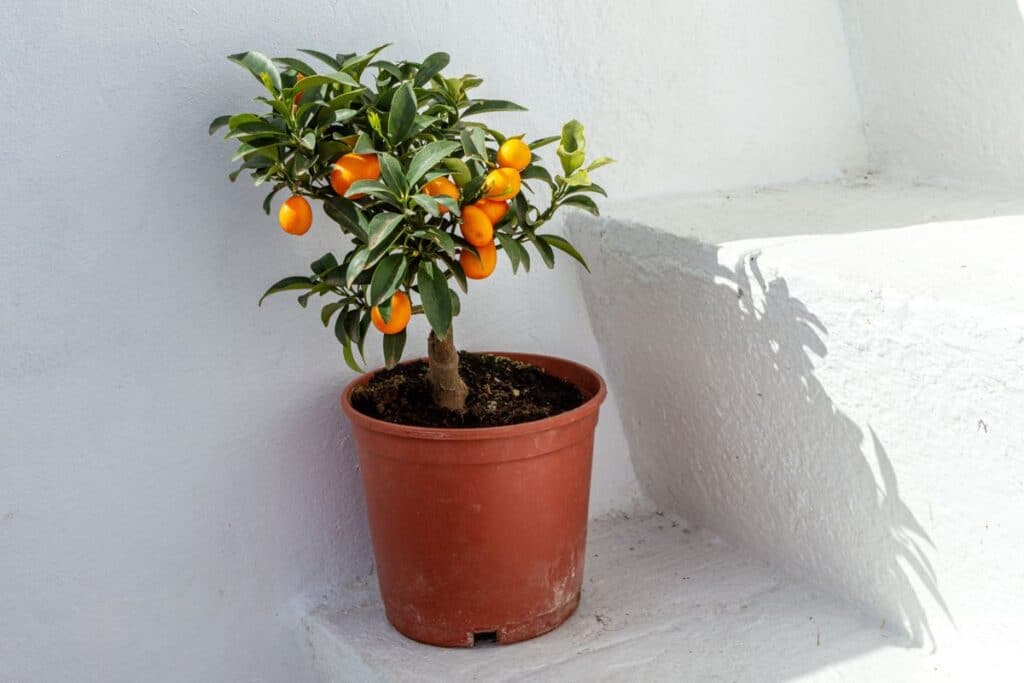
How to Grow a Bonsai Orange Tree at Home
Orange bonsai trees are pretty easy to grow but they are relatively slow growers and it will take a few years before your little tree achieves an aged appearance with a thick woody stump.
If you want to minimize scarring on your little tree then it is always best to start with a sampling with no broken limbs. Older trees can be chopped or shortened to create a small fruit tree but this usually results in a choppy end at the top of the tree which can be difficult to disguise. These older trees also tend to be challenging to train because the trunk can no longer be shaped through wiring.
With a young sapling, you can use wiring methods to create a desired shape. It might take a few more years before your tree will appear mature but the end result will be much more attractive.
Let’s take a closer look at how to grow a bonsai orange.
Propagation
You can grow an orange tree through cuttings or from seed. For most people, it is much easier to simply buy a young sampling from a local nursery. Orange trees don’t have the highest germination or pruning rate and it might take several attempts before you will get one to grow.
Here is a quick guide on how to propagate your very own little tree.
How to Propagate from Cuttings
- To propagate the orange tree from cuttings, you can start by cutting off a young branch tip of about 6 inches tall. It is best to select a branch with lots of healthy leaves.
- Remove all the leaves from the lower part of the cutting. Score the bark at the end of the cutting to encourage the growth of a new root system.
- Dip the cutting end into rooting hormones and shake off all excess powders.
- Next, you can place the cutting into a container with some potting soil. Moist the soil and press it firmly down to the cutting to remove the air around the stem.
- Place a plastic bag over the cutting to raise the humidity level and to keep the cutting from drying out.
- You can now place the pot in a warm area with lots of indirect light. In direct sunlight, the cutting will scorch.
- The bag should b opened daily to allow the cutting to breathe and you should check the soil surface daily to ensure that it stays moist. The bag can be removed after about a week.
- When roots begin to form, the cutting can be moved to a partially shaded area. Gradually expose the cutting to more sunlight to help your new plant grow.
How to Grow from Seed
- Place the orange seeds in a bowl of water and allow to soak for 24 hours. Discard any seeds that float.
- The soaked seeds can now be planted 1 inch deep in a potting soil mixture.
- Place the pot in a warm area with lots of bright indirect light.
- You can also place a bag over the pot to keep the humidity levels inside the pot high but the bag should be opened daily to allow the seeds to breathe. The bag can be removed when the seeds start to germinate.
- The seedlings should be placed in bright light and sunlight should gradually be increased as the little plant develops.
Soil
As with most citrus trees, calamondin oranges need to be planted in well-draining soil that is slightly acidic. They can grow well in loam soil types but for bonsai, it is usually best to use a bonsai potting soil mix and not soil from the garden since your little tree will need plenty of organic matter.
Pruning
The best time to prune your orange tree bonsai is in early spring before new shoots arrive. To prune the little tree, you should use a sharp but clean cutting tool. Start by removing all diseased or distressed branches or leaves. You can also remove any unwanted branches at the base and shorten branches that might be too long.
It is important not to remove all the new growth from your tree or it might struggle to develop.
If you are also styling your tree then it is best to choose a comfortable bonsai style. Wrap the trunk of the tree loosely with copper wire in a clockwise direction and shape your tree into a desired form. This is usually done in stages to prevent the stem from snapping off. If the wire becomes too tight, it should be removed or replaced.
Repotting and Transplanting
Miniature orange trees need to be repotted every 2 – 5 years to keep the root system from becoming too overgrown and to keep the tree short. It is usually best to repot your little tree in summer because your tree is at its healthiest at this stage.
Start by removing the tree roots from the pot. This can be done by watering the tree while extracting it from the pot. Trim off all excess roots but keep the primary root intact. You will need to remove about one-third of the excess roots.
The bonsai can be repotted in the same container or in a bigger container if you feel that the old container is a little bit too small.
It is, however, important to select a container with a flattened design or your little tree might not be considered a true bonsai.
How to Care for a Bonsai Orange Tree for Beginners
Once you have your little tree planted and styled, you will also need to take good care of it. Here is a quick look at the best way to care for this type of bonsai tree.
Water
Calamodins shouldn’t be overwatered or they may develop root rot. The soil also shouldn’t be left to dry out completely. Allow the soil surface to dry out before watering again but don’t let the tree’s roots become too dry.
A moisture meter is recommended when it comes to bonsai water needs if you don’t know how often to wet your small tree.
Sunlight
Bonsai orange trees can be grown outdoors or indoors but citrus trees need plenty of direct sunlight to stay healthy. Direct sunlight is especially important if you want your tree to produce fruit.
This plant prefers a full sun position but can adapt to partial shade if grown in particularly warm temperatures.
For indoor bonsai, it is best to place it in a window that receives plenty of direct sunlight.
Outdoor bonsai trees can also be brought indoors during the winter months but you will still need to place them in a window that receives lots of morning sun.
Temperature and Humidity
Orange bonsai trees prefer 50 – 70 % humidity levels. This can be difficult to achieve indoors. To raise your tree’s humidity levels, you can use a humidity tray underneath your plant or use a humidifier daily.
These tropical trees prefer warmer temperatures. They should be moved indoors when the temperatures drop below 50 degrees F. When you bring your tree indoors, you should try to position it where the temperatures are at their most constant.
Fertilizer
Bonsai trees are grown in small containers which means their nutrients are usually limited. It is very important to fertilize the tree regularly. Use a citrus fertilizer because these types of products usually have a higher pH level and can help your tree grow better. Liquid fertilizers for bonsai are the best.
you can apply liquid fertilizers about once a month and reduce the amount of fertilizer during the winter seasons.
Pests and Diseases
Your citrus tree can be plagued by all the same pests as any ordinary fruit tree. It is important to keep a look out for pests like the following;
Rust
Rust is a type of fungus that produces brown spots on the leaves of the tree. This can make the leaves fall off. All affected leaves should be removed and a suitable fungicide should be applied to the tree. You should also avoid adding moisture on top of the leaves because moisture on the leaves will cause the rust to spread.
Scales
Scales appear like oval-shaped bumps on the stem of the tree and should also be treated with a fungicide.
Slugs or Snails
These pests can damage the bonsai and can spread fungus, mold, and other diseases. They should be treated with a snail bait or pesticide.
Caterpillars
Caterpillars love to make a meal of the delicate leaves of bonsai trees. These pests can easily be cleared by hand or you can apply a fungicide.
Final Thoughts
A little orange bonsai tree can be a true joy and is sure to make quite a statement whether you keep it indoors in a sunny window, position it on a patio, or use it as a focal point in your garden. It is a lot of fun to grow and care for these interesting plants.
We hope that our guide made it a little bit easier for you to select a suitable variety and that you will have lots of fun while learning to grow and care for your very own little orange bonsai tree.
Check our guide on lemon tree bonsai and list of bonsai tree varieties to grow.
References
Reference List
Calamondin – The Most Versatile Citrus – https://aggie-hort.tamu.edu/patiocitrus/Calamondin.html
North Carolina Extension Gardener Plant Toolbox – Citrus trifoliata – https://plants.ces.ncsu.edu/plants/citrus-trifoliata/
UC Riverside – Calamondin – https://citrusvariety.ucr.edu/crc2592
Les Harrison – Calamondin – https://blogs.ifas.ufl.edu/wakullaco/2019/12/18/calamondin-citrofortunella-microcarpa-ii/
Close
*image by sergoua/depositphotos


